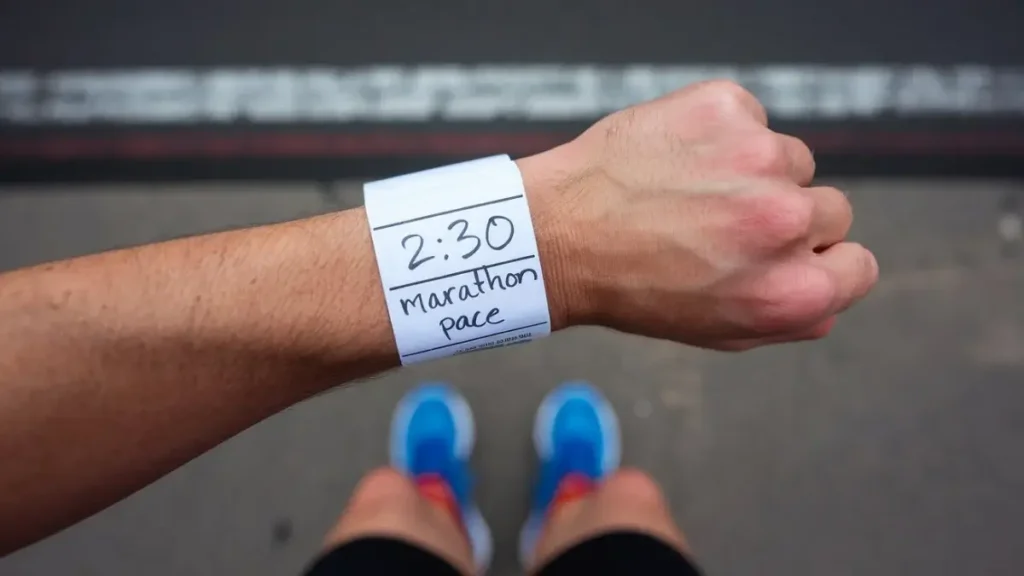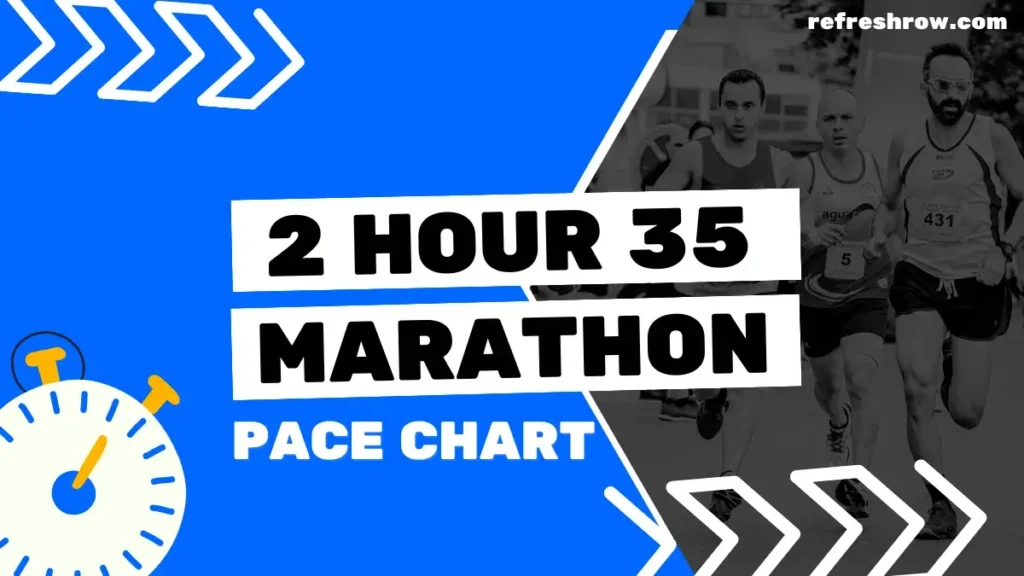To run a 6:45 hour marathon you need to run at a pace of 15:26 per mile or 9:36 per kilometer.
Following the splits below (and shaving off a second), you’ll run a sub 6:45 marathon.
I’d recommend aiming to run 1-2 minutes ahead of the split target time from 10 miles, as you’ll likely come up against crowding on race day.
6:45 Marathon Pace in Miles
| Mile | Split |
|---|---|
| 1 | 15:26 |
| 2 | 30:53 |
| 3 | 46:20 |
| 4 | 1:01:47 |
| 5 | 1:17:14 |
| 6 | 1:32:40 |
| 7 | 1:48:07 |
| 8 | 2:03:34 |
| 9 | 2:19:01 |
| 10 | 2:34:28 |
| 11 | 2:49:54 |
| 12 | 3:05:21 |
| 13 | 3:20:48 |
| 14 | 3:36:15 |
| 15 | 3:51:42 |
| 16 | 4:07:08 |
| 17 | 4:22:35 |
| 18 | 4:38:02 |
| 19 | 4:53:29 |
| 20 | 5:08:56 |
| 21 | 5:24:22 |
| 22 | 5:39:49 |
| 23 | 5:55:16 |
| 24 | 6:10:43 |
| 25 | 6:26:10 |
| 26 | 6:41:37 |
| 26.2 | 6:45:00 |
Download
6:45 Marathon Pace in KM
| KM | Split |
|---|---|
| 1 | 9:36 |
| 2 | 19:12 |
| 3 | 28:48 |
| 4 | 38:24 |
| 5 | 48:00 |
| 6 | 57:36 |
| 7 | 1:07:12 |
| 8 | 1:16:48 |
| 9 | 1:26:24 |
| 10 | 1:36:00 |
| 11 | 1:45:36 |
| 12 | 1:55:12 |
| 13 | 2:04:48 |
| 14 | 2:14:24 |
| 15 | 2:24:00 |
| 16 | 2:33:36 |
| 17 | 2:43:12 |
| 18 | 2:52:48 |
| 19 | 3:02:24 |
| 20 | 3:12:00 |
| 21 | 3:21:36 |
| 22 | 3:31:12 |
| 23 | 3:40:48 |
| 24 | 3:50:24 |
| 25 | 4:00:00 |
| 26 | 4:09:36 |
| 27 | 4:19:12 |
| 28 | 4:28:48 |
| 29 | 4:38:24 |
| 30 | 4:48:00 |
| 31 | 4:57:36 |
| 32 | 5:07:12 |
| 33 | 5:16:48 |
| 34 | 5:26:24 |
| 35 | 5:36:00 |
| 36 | 5:45:36 |
| 37 | 5:55:12 |
| 38 | 6:04:48 |
| 39 | 6:14:24 |
| 40 | 6:24:00 |
| 41 | 6:33:36 |
| 42 | 6:43:12 |
| 42.2 | 6:45:00 |
Download
Other Marathon Pace Charts
Targeting a different time?
Check out the Full Marathon Pace Chart in Miles or KM
Or select a specific finishing time below:
| 3:00 | 4:00 | 5:00 | |
| 3:05 | 4:05 | 5:15 | |
| 3:10 | 4:10 | 5:30 | |
| 3:15 | 4:15 | 5:45 | |
| 3:20 | 4:20 | 6:00 | |
| 3:25 | 4:25 | 6:15 | |
| 2:30 | 3:30 | 4:30 | 6:30 |
| 2:35 | 3:35 | 4:35 | 6:45 |
| 2:40 | 3:40 | 4:40 | 7:00 |
| 2:45 | 3:45 | 4:45 | |
| 2:50 | 3:50 | 4:50 | |
| 2:55 | 3:55 | 4:55 |
Training for a 6:45 Marathon
Is 6:45 a Good Marathon Time?
Well, what do the stats say?
Run Repeat conducted a study that contains 19,614,975 marathon results from more than 32,335 races across the globe, here is how a 6:45 marathon compares against age and gender for the races recorded:
| Overall | You’re faster than 2.1% of all runners. |
| Male | You’re faster than 1.6% of males. |
| Female | You’re faster than 2.9% of females. |
| <20 | You’re faster than 3.7% of under 20s. |
| 20-29 | You’re faster than 1.4% of 20-29 year olds. |
| 30-39 | You’re faster than 1.3% of 30-39 year olds. |
| 40-49 | You’re faster than 1.5% of 40-49 year olds. |
| 50-59 | You’re faster than 2.5% of 50-59 year olds. |
| >60 | You’re faster than 6.8% of over 60s. |
Training Runs and Paces for a 6:45 Marathon
To break a 6:45 marathon you’ll need to do some serious distance in your training, I recommend at least 10 miles (16km) per week.
You’re also going to need to make sure you’ve crossed off these milestones for other race distances:
- A 5k in 42:05
- A 10k in 1:28:20
- A half marathon in 3:05:00
Training Paces
| Pace | Mins per Mile | Mins per KM |
|---|---|---|
| Easy | 17:24 | 10:49 |
| Steady | 15:27 | 9:35 |
| 10k | 14:10 | 8:48 |
| 5k | 13:35 | 8:26 |
| 1 Mile | 12:37 | 7:53 |
Weekly Mileage Targets
| Target Mileage: | Gradually increase your weekly mileage from 6 miles (10 km) to a peak of 12 miles (19 km). |
| Incremental Increase: | Increase mileage by approximately 10% each week, with every fourth week as a recovery week where mileage is reduced by 20-30%. Make sure to taper for the last 1-2 weeks. |
Long Run Structure
| Total Distance: | Build up to long runs of 8-9 miles (13-14.5 km). |
| Segment Example: | First 3 miles (5 km): Easy pace, heart rate 140-150 bpm (approximately 18:00/mile or 11:11/km). Next 1 mile (1.6 km): Fast pace at 12:30/mile (7:46/km). Next 2 miles (3.2 km): Medium effort, heart rate around 160 bpm (approximately 13:30/mile or 8:24/km). Final 3 miles (5 km): Return to easy pace at 18:00/mile (11:11/km). |
Why This Works: By incorporating varied paces during your long runs, this plan helps your body adapt to handling different speeds and intensities over time. It improves endurance and prepares you for the challenging later stages of a marathon, where switching between efforts is common.
Alternating Long Runs: Alternate between structured long runs (easy/fast segments) and easier long runs. For easier long runs, maintain a steady, comfortable pace throughout, focusing on mileage rather than speed to aid recovery.
Speedwork Sessions
| Short Intervals: | – 400m repeats at 6:00 per interval (7:27/km). – Aim for 3-4 repetitions with equal time for recovery. |
| Mile Repeats: | – 1 mile repeats at 12:30 per mile (7:46/km). – Aim for 2 repetitions with a 1-2 minute recovery jog. |
| Longer Intervals: | – 2 mile repeats at 12:45 per mile (7:56/km). – Aim for 2 repetitions with a 2-3 minute recovery jog. |
Recovery and Rest Days
| Rest Days: | Include 2 rest days per week to give your body time to recover and prevent burnout. |
| Easy Run Days: | Include 1-2 easy run days per week at a relaxed pace of 18:30/mile (11:29/km), covering 2-3 miles (3-5 km) per day. Try to keep your heart rate below 140 bpm on easy days to ensure proper recovery and aerobic development. |
My Tips to Run a Sub 6:45 Marathon
Start Slow, Even Slower Than Planned
On marathon day, the excitement can easily push you to start faster than intended.
Try to resist the urge to follow the crowd and instead start slower than your planned pace for the first few miles.
This will help conserve energy for the later stages when fatigue hits.
Think of it as a warm-up phase to settle into your rhythm.
You can always make up time later in the race, but starting too fast is a common mistake for beginners that leads to early burnout.
My personal preference is to find a pacer before the race starts and ask them if they’re starting slower, then stick with them at the beginning to help keep me accountable!
Use Landmarks, Not Just Mile Markers
Many marathoners focus solely on mile markers, but this can become discouraging if they start to feel further and further apart as fatigue hits.
I like to identify landmarks along the course – whether it’s a specific building, bridge, or where I know my friends are cheering – and use those to gauge my progress.
(this is why the London marathon is my fav, so many amazing buildings!)
Mentally tick them off as you pass.
This keeps your mind engaged and motivated, especially in the slower stretches where the next mile marker seems too far away.
Hydration Strategy: Drink Before You’re Thirsty
A slower marathon means you’ll be on the course for a longer period, and dehydration can sneak up on you.
Make it a point to start hydrating early – before you feel thirsty.
Take small sips at every water station, even if you don’t feel like you need it.
This proactive hydration strategy prevents the dreaded late-race fatigue caused by dehydration.
You can also consider taking a hydration pack with you if during your training you find fatigue is setting in really early.
Because you’re running slower than others, the water stations will be further apart timewise.
A hydration pack means you’ve got water “on-tap” whenever you need it.
Plan and Practice Your Finish Line Routine
You’ve made it, but now what!?
Crossing the finish line is always going to be an emotional moment, but it can also be physically overwhelming.
Have a plan for how you’ll recover right after crossing the line.
Practice this in training: take a deep breath, slow down your walking, and gently stretch your legs.
This simple routine will help you avoid cramping or muscle tightness in the final moments, allowing you to savor your accomplishment without any discomfort.
And don’t forget your recovery pack with all your fav treats and a wooly jumper!


Row Brown is the founder of Refresh Row. He is a keen marathon runner, his favorite being the London Marathon. He’s now set himself the mission of Running the Entire Length of Spain, which is scheduled for late 2024.


